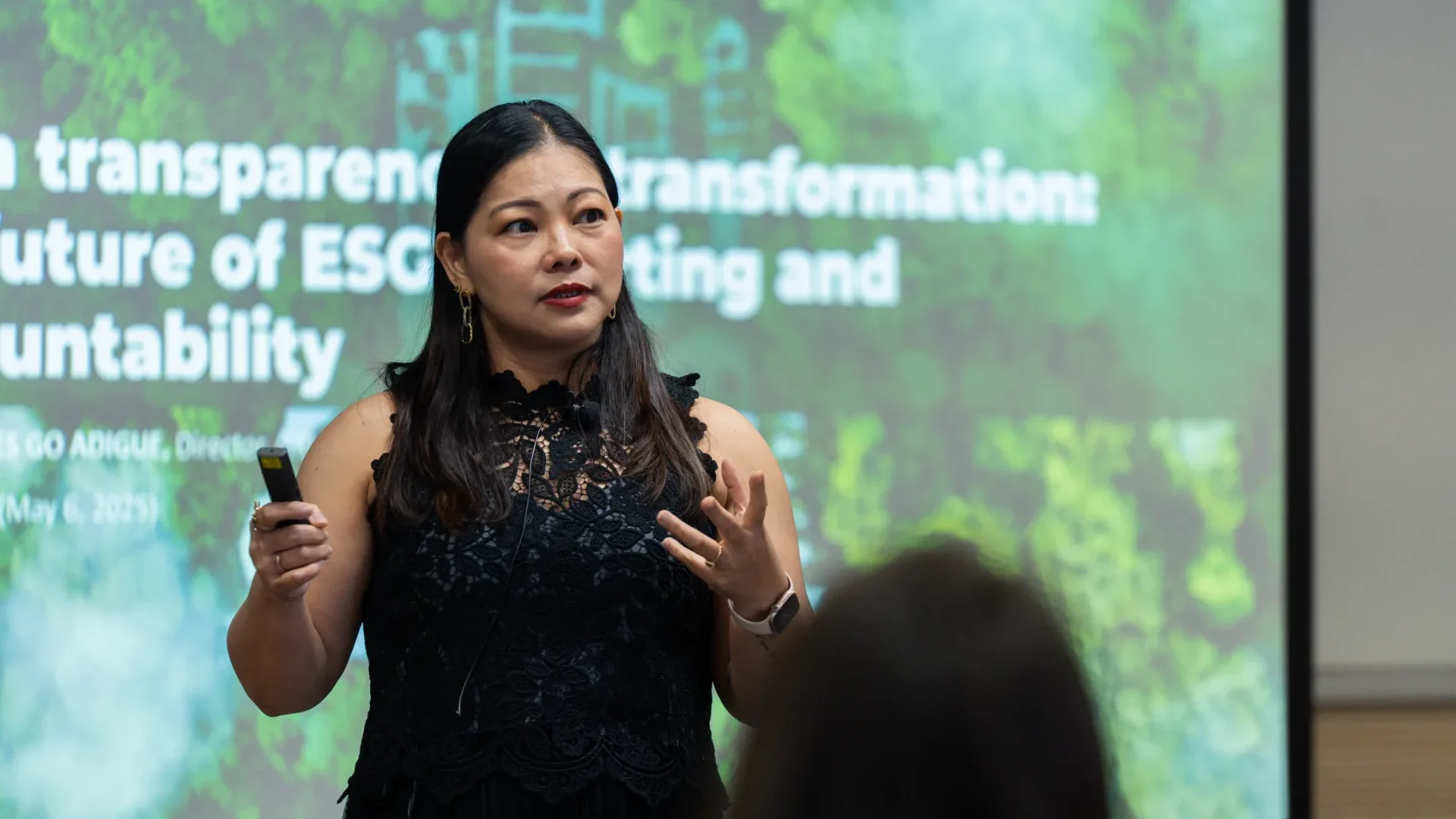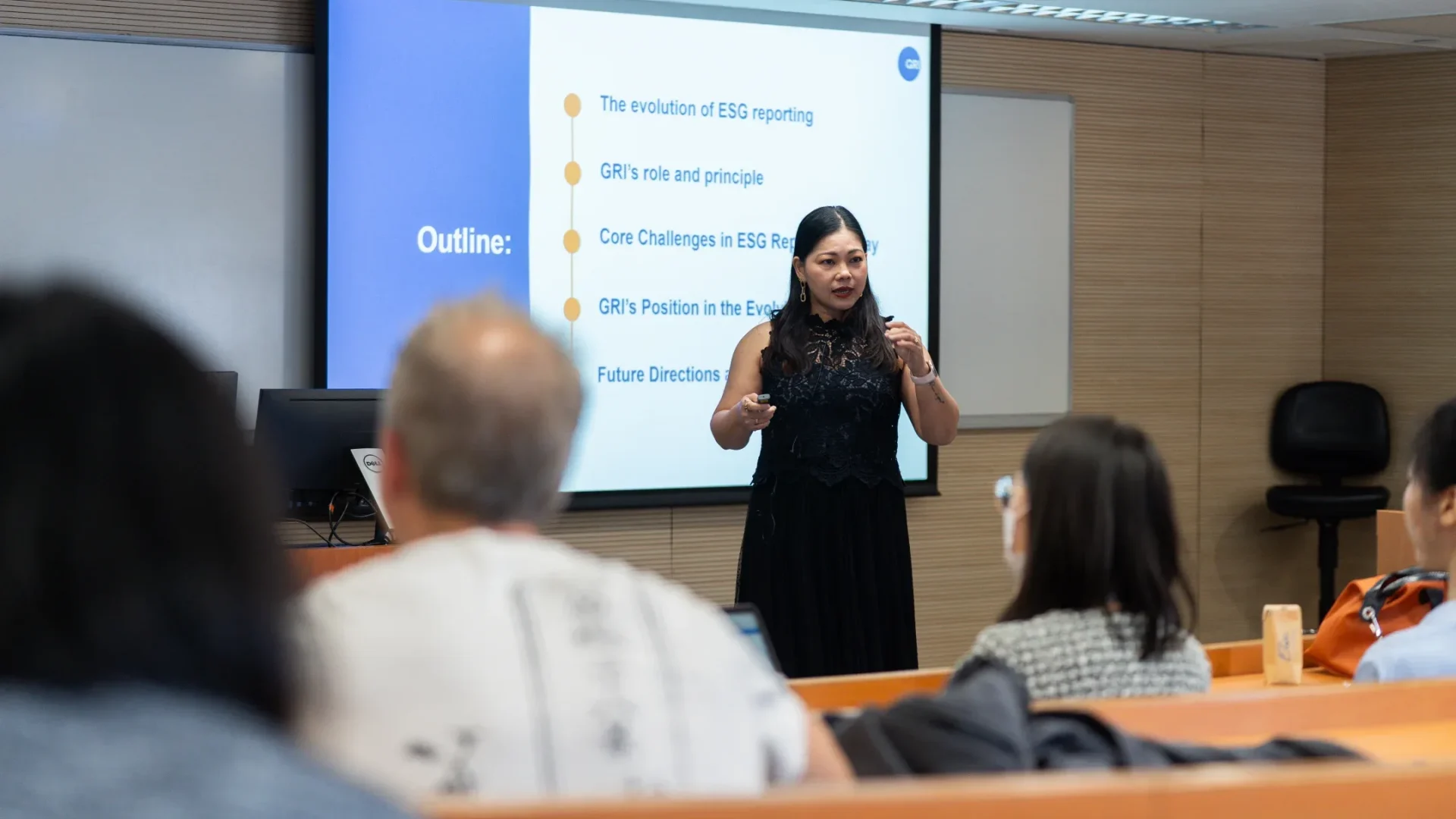
HKU Jockey Club Enterprise Sustainability Global Research Institute
World-Class Hub for Sustainability
Seminar Recap:
The Evolution of ESG Reporting: From Transparency to Transformation, and What Lies Ahead?
The Evolution of ESG Reporting: From Transparency to Transformation, and What Lies Ahead?
- ESG reporting has evolved from voluntary initiatives (since GRI’s founding in 1997) to a regulatory imperative. Yet, fragmented standards continue to challenge businesses.
- On May 6, our Institute partnered with HKU Business School’s Accounting and Law Area to host a closed-door seminar on this critical topic. We were honoured to welcome Dr. Allinnettes Adigue, Director of GRI ASEAN Network, also the teaching affiliated member of our institute, as the keynote speaker, to share invaluable insights and sparked thought-provoking discussions with faculty and students.
- Centered around the theme “From Transparency to Transformation: The Future of ESG Reporting and Accountability,” the discussion provided an in-depth yet accessible exploration of the evolution of ESG reporting, the core challenges it currently faces, as well as future trends and opportunities, offering intriguing observations and unique insights. Let’s revisit the key takeaways!







Key Takeaways
1. The Evolution of ESG Reporting: From Voluntary to Mandatory, with Proliferating Standards and Growing Complexity
- Since the establishment of the Global Reporting Initiative (GRI) in 1997, ESG reporting has evolved from voluntary initiatives to mandatory requirements in an increasing number of jurisdictions. According to ESG Book’s latest research, global ESG regulations have surged by 155% in the past decade, with 1,255 policy interventions enacted worldwide since 2011—a sharp increase from the 493 regulations recorded between 2001 and 2010[1].
- We have also seen the emergence of key frameworks and standards, including the Greenhouse Gas (GHG) Protocol, the UN Global Compact, the Sustainability Accounting Standards Board (SASB), the Task Force on Climate-related Financial Disclosures (TCFD), and more recently, the International Sustainability Standards Board (ISSB).
- The continuous expansion of ESG regulations reflects growing governmental emphasis on corporate environmental, social, and governance responsibilities. However, the rapid proliferation of standards has also introduced challenges—companies and regulators now face the dilemma of selecting appropriate disclosure frameworks to effectively address diverse stakeholder expectations.
2. Double Materiality: Integrating Financial and Impact Perspectives for Holistic Sustainability Disclosure
A robust ESG reporting framework typically comprises three core components: general disclosure requirements, sector-specific considerations, and theme-specific guidance—collectively enabling adaptable yet comprehensive reporting. Current standards diverge in their emphasis:
- • Financial Materiality (e.g., ISSB): Focuses on how sustainability issues affect corporate financial performance and long-term value creation.
- • Impact Materiality (e.g., GRI): Assesses an organization’s positive/negative impacts on the environment, society, and economy.
These perspectives are complementary, rather than contradictory. Adopting a Double Materiality approach provides stakeholders with a complete picture of a company’s sustainability performance, risks, and opportunities.
3. Key Challenges in ESG Reporting: From Greenwashing Risks to Data Quality
Despite significant progress, ESG reporting still faces critical challenges in disclosure practices:
- • Regulatory Fragmentation: Multinational corporations must navigate divergent ESG disclosure requirements across jurisdictions, often with conflicting priorities and standards, significantly increasing compliance complexity.
- • Heightened Technical Demands: Rising regulatory expectations, such as data accuracy, verifiability, and standardized metric calculations—create compliance hurdles, particularly for organizations lacking dedicated ESG teams.
- • SMEs Capacity Gaps: Systematic ESG disclosure presents unique challenges for small and medium enterprises (SMEs), as it necessitates:
- 。 Specialized resource allocation beyond typical operational capacities
- 。 Structural adaptations to establish data collection and verification processes
- 。 Proportionally higher costs relative to organizational scale
- • Greenwashing Concerns: The growing emphasis on ESG performance has led to selective disclosure or exaggerated sustainability claims, undermining report credibility and misleading stakeholders in their decision-making processes.
4. Future Directions and Opportunities: Digitization, Harmonization, and Academia’s Role
Looking ahead, the field of ESG reporting will see several key developments.
- • Tech-driven disclosure efficiency: AI and digital tools are transforming data collection, analysis, and reporting workflows
- • Standardized Yet Strategic disclosure: The industry will enhance transparency and comparability while maintaining flexibility in corporate practices strategically, enabling companies to tailor disclosures that highlight their distinctive ESG value propositions.
- • Embedded ESG into decision-making: ESG factors are becoming hardwired into policies, supply chains, and investment frameworks
- • Academia’s empowerment: From theory-building to methodological breakthroughs – continues powering this transformation.
Closing Remarks
- With ESG regulations multiplying, especially region- and sector-specific disclosure mandates, how can companies ensure compliance while maintaining operational flexibility? How to align with global reporting standards and at the same time, addressing unique corporate needs to demonstrate true ESG leadership, not just box-ticking?
- These challenges demand ongoing innovation and discussion, and our seminar isn’t about solutions—it’s about cross-sector dialogue. By convening experts, we aim to spark fresh ideas at the intersection of regulation, strategy, and impact.
Acknowledgments
- Our thanks to:
- • The Area of Accounting & Law faculty, HKU Business School, especially Prof. Xin WANG (Area Head, Affiliated Researcher of the Institute), Prof. Jeffrey NG (Associate Director of the Institute), and Travis CHOW.
- • Dr. Allinnettes Adigue for her thought-provoking insights.
- • All participants for driving this fruitful and interactive discussion.